Camogli: the down-to-earth seaside town loved by the Italians
This Italian Riviera port is where locals go on holiday for ocean swims, fresh fish and walks in the hills. And there’s not a superyacht in sight.
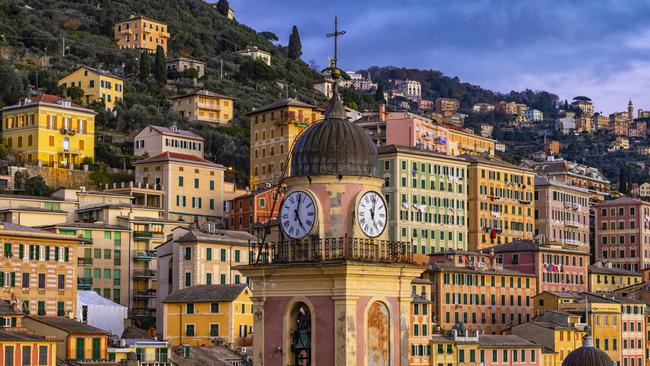
“You’ve come at the right time of year,” the fisherman at the port in Camogli tells us as he mends his net. “It’s not too hot, and you can relax, without the crowds.” Phew. Booking a holiday to a seaside town in northwest Italy in November had felt risky, but I’d ignored warnings of possible rain or that everywhere would be closed and optimistically packed my swimsuit. Thankfully the fisherman is right. My boyfriend and I have chosen Camogli as a compromise. He wants one last dose of sunshine before the northern winter, and I’m not a fan of drop-and-flop holidays.
The town, in Golfo Paradiso, Liguria, is where people from Milan and Genoa come in the summer for ocean swims, fresh fish and walks in the hills among the orange trees. It’s half an hour from Genoa by train, and although it’s near glitzy Portofino, it has been saved from its neighbour’s influx of superyachts. I don’t know how they’ve pulled this off. It has just as much appeal and is well connected. It could be something to do with it being a working fishing port, which means it’s harder to park a yacht. “Portofino is for Americans. Camogli is for us Italians,” the fisherman says.
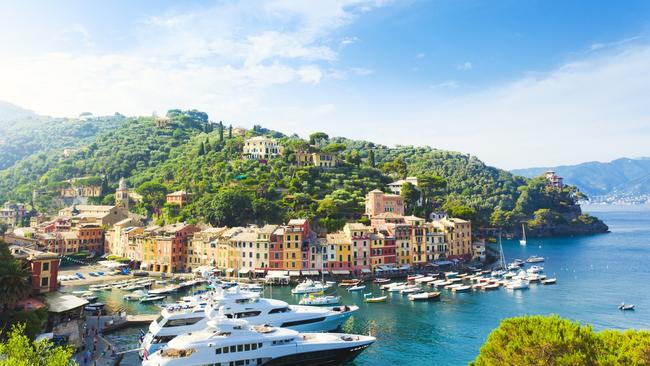
Our first sight of the town, on the train from Genoa airport, is of rows of pretty pastel houses against the blue sky and a sweep of sea. Each building is painted a different colour so the fishermen can spot their homes while out in their boats (Camogli means “the houses of wives” because the men were away so much). At the end of the bay is our hotel, Cenobio dei Dogi, two grand pink and yellow villas, giant Battenberg cake-style, in a prime spot with beautiful sea views. In the 16th century, the Genovese doges, who clearly had excellent taste, had a summer house here. There’s a private beach with a jetty for diving off, and the sea is warm enough to swim in without shrieking, although I am glad of the hot showers on the beach afterwards. The Italians don’t really do cool-weather swimming; everyone packs away their bathers on October 1. The hotel also has a heated outdoor saltwater pool. I start each day with a sea dip before a breakfast buffet fit for a doge: eggs, pastries and apparently infinite varieties of focaccia.
This 16km stretch of coastline in Liguria claims to be the place from where the bread originates, and there is serious competition about who makes the best. Our first stop is Revello bakery on the seafront, where the bakers theatrically twirl the dough in the air. It’s thought focaccia was invented in 14th-century Liguria when villagers hiding in the hills from Saracen pirates threw it together from whatever ingredients they could find. Today it’s more elaborate, with toppings such as mortadella, pistachio and dabs of local pesto. There is also focaccia col formaggio, made from thinner dough and filled with salty white cheese.
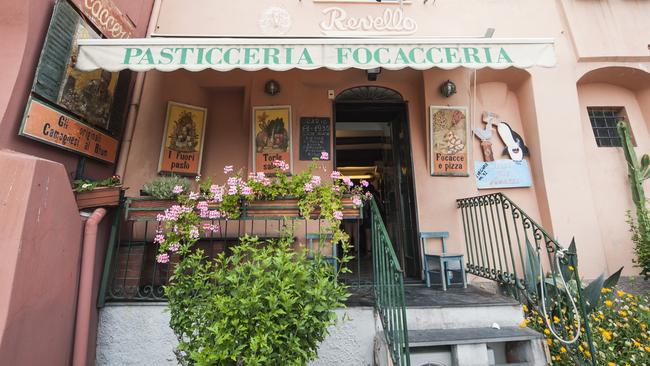
We spend our days exploring the area. The friendly hotel staff recommend a walk to Portofino from the neighbouring town Santa Margherita Ligure, a four-minute train ride away. The walk is about 5km but feels longer because it’s so up and down, delivering gorgeous views as we wind past olive groves and tiny chapels, peeking through the fence at Dolce and Gabbana’s villa (with its massive cabbages growing in the garden) before arriving at Portofino ready for more focaccia. This tiny harbour is where Richard Burton proposed to Elizabeth Taylor. I’ve never seen so many designer shops in such a small space, among them two Louis Vuittons and a Loro Piana (I spot some of the outfits from the TV series Succession in the window). I can see why the super-rich are drawn to the turquoise waters, pine trees and colourful buildings, but the shops and restaurants could be anywhere in the world. It makes me even more glad to be staying in down-to-earth Camogli. When we return to our hotel the whole town glows warmly in the late-afternoon sun. We meander along the seafront, drawn in to the Libreria Ultima Spiaggia bookshop, which has a good range of (mostly Italian) fiction, non-fiction and children’s books as well as postcards of the town through the years. One pictures a 4m-wide frying pan, first used in 1952 at Sagra del Pesce, a festival to give thanks to San Fortunato, the patron saint of sailors and fishermen, for providing fish during World War II. The pan is still used for an annual feast that takes place on the second Sunday in May, and there’s a replica on display on Via Giuseppe Garibaldi, not far from where the lively Wednesday food market is held.
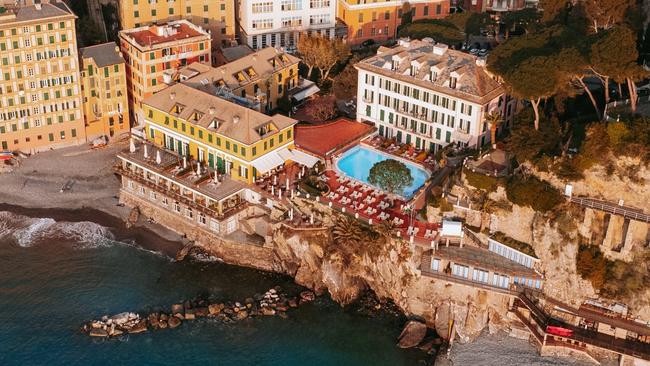
Sunset in Camogli is an event. Our hotel’s terrace, with its panoramic view, is one of the best places to take it in, but the bar La Cage aux Folles, a fishermen’s haunt, is fun too. It has a well-stocked bar, fresh seasonal snacks from about $8 and live music in high season.
I’d like to go back in high summer when all the restaurants are open, but going in November makes choosing a venue easier. We like Da Paolo, just away from the main drag, which is small with dark wooden chairs, white tablecloths and one waitress, who doesn’t speak English but manages to explain everything using body language and smiles. We start with fresh anchovies fried with lemon, and artichoke with rosetti, a small white fish with a sweet, almost lobster-like taste that’s caught only off the Italian coast. The waitress brings the catches of the day for us to assess; we point at a plump sea bream and enjoy it served with a delicate lemon and white wine sauce and potatoes.
The most famous restaurant in the area, though, is La Cantina in San Fruttuoso, in a bay between Camogli and Portofino. Steve Coogan and Rob Brydon went there on their television series The Trip. Sadly it is closed when we visit – another reason to return. But going in low season means we have this cove, a suntrap surrounded by pine trees and a few cacti, to ourselves.
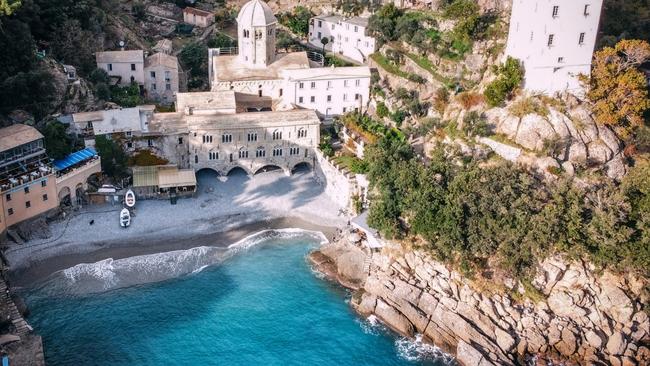
You can hike here but the receptionist at our hotel looks at our shoes and shakes her head. There have been rock falls recently and climbing gear is advised, so instead we take a 25-minute ferry from Camogli. We swim in the crystal clear ocean and try to spot the Cristo degli Abissi, an underwater bronze statue of Jesus. A well-preserved abbey overlooks the beach. It dates from the 11th century and is home to the tombs of the Doria family, who rebuilt it in the 13th century and added a palace, now in ruins.
After a few days in Camogli I feel relaxed, and could happily stay put, watching the changing light wash over the town throughout the day, but we have one last stop in Genoa. Walking through the city’s winding streets, we are reacquainted with a faster metropolitan pace. We go to see Caravaggio’s Ecce Homo painting at the grand Palazzo Bianco, which has a tranquil garden. There’s time for a final meal, at the delicatessen Cacio e Pepe, where we share a pesto lasagne, fried white fish and grilled courgette. We mull over our days in Camogli; Italy in November has been a revelation. My only regret is that I packed too many jumpers.
In the know
Cenobio dei Dogi has standard sea view rooms from €220 ($360) a night, twin-share.
Susannah Butter was a guest of Cenobio dei Dogi.
THE TIMES
If you love to travel, sign up to our free weekly Travel + Luxury newsletter here.


